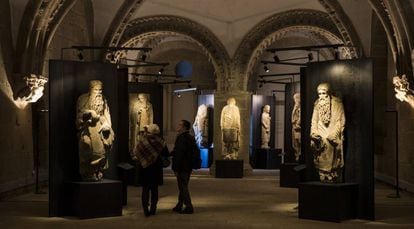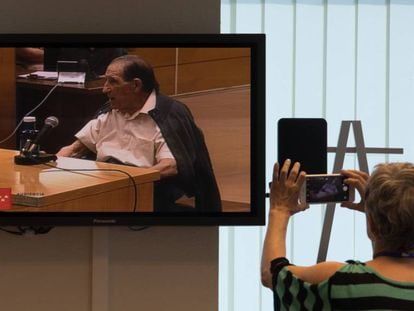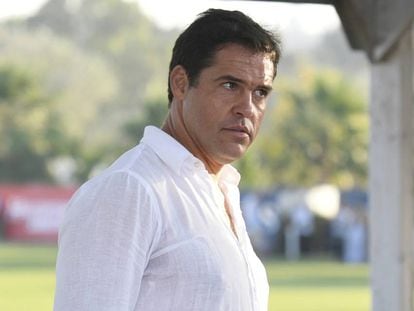Why do these 800-year-old statues belong to a Franco-owned real estate agency?
The local government in Santiago de Compostela says it is the real owner of the invaluable sculptures, which once graced the cathedral but are now kept in the summer house of the Spanish dictator’s family


When Master Mateo began to sculpt the peristyle for the Portico of Glory at Santiago de Compostela Cathedral in 1168, he had no idea that his statues of Abraham and Isaac would end up in the hands of Pristina SL,. a real estate agency belonging to Francis Franco, the grandson of Spanish dictator Francisco Franco.
It’s obvious that Carmen Polo saw them when she walked into City Hall, became infatuated with them, and took them away
Lawyer Xoaquín Monteagudo
Nor did a Madrid court now tasked with determining the legal owner of the invaluable Romanesque-style artworks, originally meant to decorate a temple that is a UNESCO World Heritage Site and the annual destination for thousands of pilgrims on the Camino de Santiago route.
The court has given the Franco family until November 19 to prove ownership of the more than 800-year-old statues. The family allegedly bought the figures of the biblical prophets in 1954, but their lawyers admit they have no documentary proof of purchase.
The internationally renowned Portico of Glory, widely considered the best example of Spanish Romanesque art, was originally larger and contained an antechamber with a large central archway and various sculptures of the prophets. Behind this was the space that is today known as the Portico de la Gloria.
But the site was modified in 1521, and in the 18th century the outside gallery completely disappeared. The sculptures that once stood there were scattered across the country. Only nine of the original statues remain: four in the cathedral museum, two at the Pontevedra Provincial Museum, one in a private collection and two – those of Abraham and Isaac – which are owned by a property developer based in Madrid, at the very same address where Franco’s wife Carmen Polo lived until she died.
But how can the statues’ “tax address” be in the Spanish capital when they are located in Pazo de Meirás, Franco’s summer home in A Coruña, in the northwestern region of Galicia? This is the basis of the legal dispute between the city of Santiago de Compostela and the Franco family.
The only thing that’s clear is that on July 25, 1954, both statues were standing inside the entrance hall of Santiago City Hall. Franco and his wife had visited the city the day before to take part in a “festive and patriotic day in Compostela,” according to an article in the local newspaper La Voz de Galicia.
But from here on the accounts differ. City Hall says that in 1948 it bought three sculptures – including the two of Abraham and Isaac – from Santiago de Puga, Count of Ximonde, and it has the municipal records to prove it. The city paid 60,000 pesetas (€360) for the sculptures and placed them in the stairway of City Hall, located inside Pazo de Raxoi Palace. If the statues were ever moved from Santiago de Compostela, the local government would have to pay the count another 400,000 pesetas (€2,400).
City Hall says that it bought the statues of Abraham and Isaac in 1948
According to city officials, the statues disappeared after Franco’s visit to the city and suddenly reappeared in Pazo de Meirás, their summer residence. “It’s obvious that Carmen Polo saw them when she walked into City Hall, became infatuated with them, and took them away,” says Xoaquín Monteagudo, a lawyer representing the city of Santiago de Compostela.
But the lawyer for the Franco family, Juan José Arizcorbe of the law firm Milans del Bosch, says the Francos “have a deed [of the private sale]” even if they have no documentation to prove it. The lawyer claims the City Hall also has no proof, and has said that enough years have passed since the alleged sale that the ownership of the statues cannot be questioned.
But the local government disagrees. When Carmen Franco Polo died in December 2017, her seven heirs inherited the summer home in A Coruña as well as the two sculptures, which are of incalculable value.
The trial was set to begin on Monday, but had to be postponed after Francis Franco decided to transfer his share to the family-owned real estate firm Pristina. This means that the judge has to change the lawsuit to make it against six heirs and one company, rather than seven heirs.
“These are delay tactics. We will see each other again in court in a month and maybe another one of the heirs will have done the exact same thing. And there are still six heirs left to go. And so time goes by,” says Monteagudo in a prophetic tone appropriate to the objects of dispute.
English version by Melissa Kitson.












































